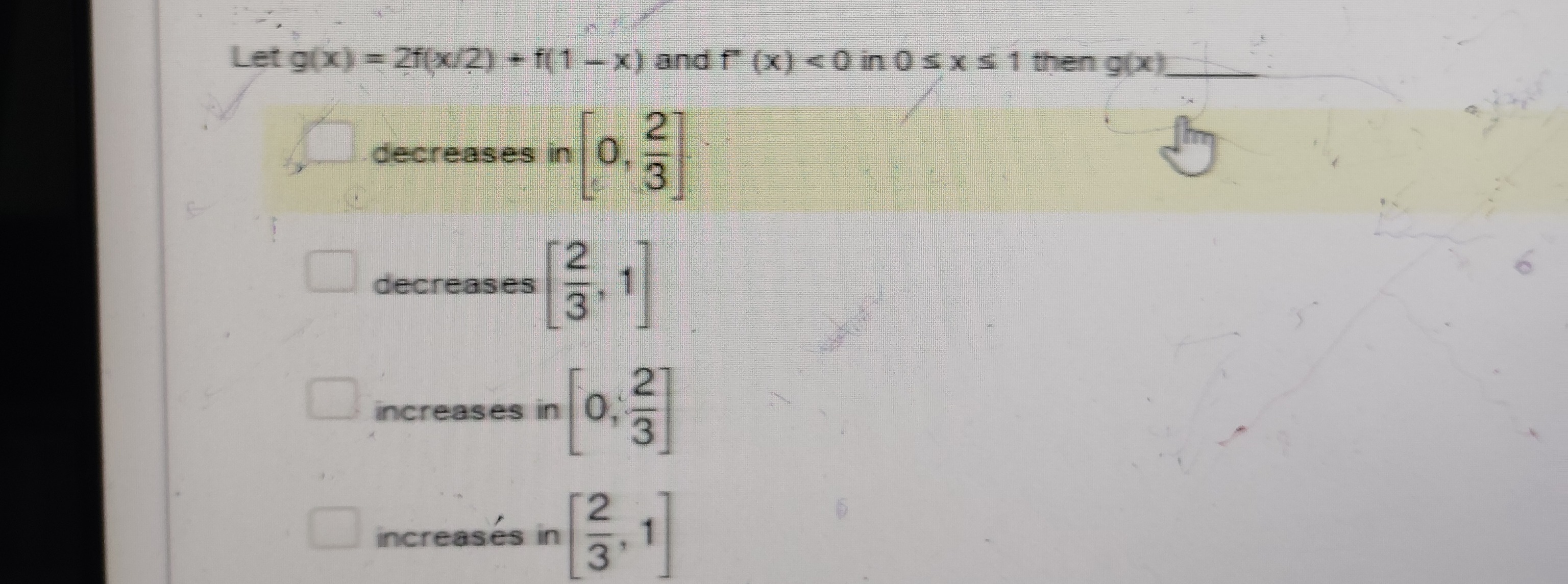Question
Question: Let g(x) = 2f(x/2)+f(1-x) and f"(x) < 0 in 0 ≤ x ≤ 1 then g(x)...
Let g(x) = 2f(x/2)+f(1-x) and f"(x) < 0 in 0 ≤ x ≤ 1 then g(x)

decreases in [0,32]
decreases [32,1]
increases in [0,32]
increases in [32,1]
decreases [32,1], increases in [0,32]
Solution
The function given is g(x)=2f(x/2)+f(1−x) for x∈[0,1].
We are given that f′′(x)<0 for x∈[0,1]. This implies that the first derivative f′(x) is a decreasing function in the interval [0,1].
To determine the monotonicity of g(x), we need to find the sign of its derivative g′(x).
Differentiating g(x) with respect to x, we use the chain rule:
g′(x)=dxd(2f(x/2))+dxd(f(1−x))
g′(x)=2⋅f′(x/2)⋅dxd(x/2)+f′(1−x)⋅dxd(1−x)
g′(x)=2⋅f′(x/2)⋅21+f′(1−x)⋅(−1)
g′(x)=f′(x/2)−f′(1−x)
Now, we need to determine the sign of g′(x) for x∈[0,1]. The sign depends on the comparison between f′(x/2) and f′(1−x).
Since f′(x) is a decreasing function, f′(a)>f′(b) if a<b, and f′(a)<f′(b) if a>b.
Let's compare the arguments of f′: x/2 and 1−x.
We find the point where the arguments are equal:
x/2=1−x
x=2(1−x)
x=2−2x
3x=2
x=2/3.
At x=2/3, x/2=1/3 and 1−x=1/3. So f′(x/2)=f′(1−x), which means g′(2/3)=0.
Now consider the intervals x<2/3 and x>2/3 within the domain [0,1].
Case 1: x∈[0,2/3)
For x<2/3, we compare x/2 and 1−x.
x/2<1−x⟺x<2−2x⟺3x<2⟺x<2/3.
So, for x∈[0,2/3), we have x/2<1−x.
Since f′(x) is a decreasing function, if a<b, then f′(a)>f′(b).
Here, a=x/2 and b=1−x, with a<b.
So, f′(x/2)>f′(1−x).
Therefore, g′(x)=f′(x/2)−f′(1−x)>0 for x∈[0,2/3).
Case 2: x∈(2/3,1]
For x>2/3, we compare x/2 and 1−x.
x/2>1−x⟺x>2−2x⟺3x>2⟺x>2/3.
So, for x∈(2/3,1], we have x/2>1−x.
Since f′(x) is a decreasing function, if a>b, then f′(a)<f′(b).
Here, a=x/2 and b=1−x, with a>b.
So, f′(x/2)<f′(1−x).
Therefore, g′(x)=f′(x/2)−f′(1−x)<0 for x∈(2/3,1].
Combining the results:
g′(x)>0 for x∈[0,2/3) and g′(x)<0 for x∈(2/3,1].
At x=2/3, g′(2/3)=0.
This means g(x) is increasing on the interval [0,2/3] and decreasing on the interval [2/3,1].
The options are multiple choice checkboxes, indicating multiple correct answers are possible.
Based on our analysis, options 2 and 3 are correct.
